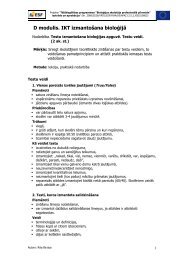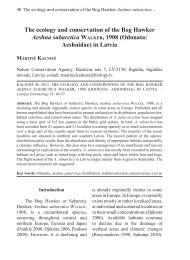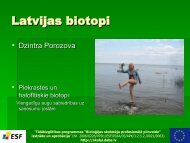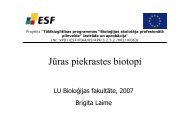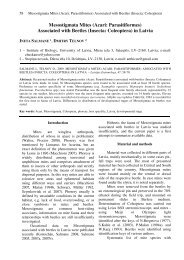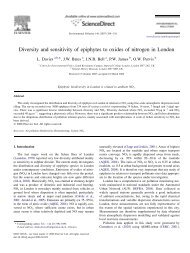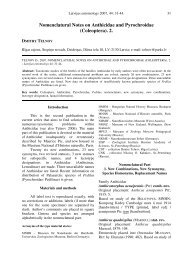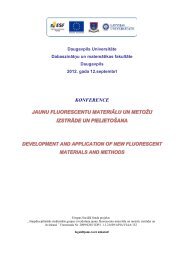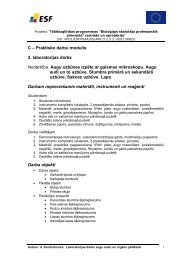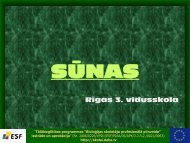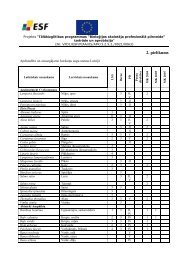Odonata - Entomological Society of Latvia - Latvijas Daba
Odonata - Entomological Society of Latvia - Latvijas Daba
Odonata - Entomological Society of Latvia - Latvijas Daba
You also want an ePaper? Increase the reach of your titles
YUMPU automatically turns print PDFs into web optimized ePapers that Google loves.
less than 100 observations and only 8 have less than 10 observations. This means that, at least<br />
partially, the obtained information is a precise and correct representation <strong>of</strong> the distribution <strong>of</strong> most<br />
species in <strong>Latvia</strong>.<br />
4.2. THE SPATIAL DISTRIBUTION OF DRAGONFLY IMAGINES IN MICROHABITATS OF RAISED BOGS<br />
Population research During the research 14 dragonfly species were found and three <strong>of</strong> them<br />
were singled out as dominating species – Enallagma cyathigerum, Lestes sponsa and Leucorrhinia<br />
albifrons. The greatest diversity <strong>of</strong> species and the greatest number <strong>of</strong> individuals was found in<br />
habitats with open water bodies. As many tyrphophilic (or: typical for mires) species need open<br />
water areas (van Duinen et al. 2003; Mazerolle et al. 2005), tree vegetation negatively affects<br />
dragonfly species richness (Corbet 2004). This explains the fact that the highest number <strong>of</strong><br />
dragonfly species was observed in bog pools in open areas. However, the number <strong>of</strong> dragonfly<br />
species was also higher in pools in pine stands. Here an important role is played by the density <strong>of</strong><br />
trees and the shading it creates. If the tree vegetation is sparse and does not produce much shading,<br />
then the presence <strong>of</strong> trees is not the main negative aspect for any <strong>of</strong> the species. For example,<br />
Leucorrhinia dubia is sometimes observed flying in forests (Pajunen 1962). The lowest diversity <strong>of</strong><br />
dragonfly species was recorded in an open bog area <strong>of</strong> vegetation without open water areas and an<br />
insignificant presence <strong>of</strong> trees. These areas are characterized by a complex <strong>of</strong> hummocks and<br />
depressions, where there was not a large variety <strong>of</strong> dragonfly species (Suh, Samways 2005). On the<br />
other hand, these are suitable habitats for specialist species (species with a very narrow ecological<br />
range, the existence <strong>of</strong> which requires very specific conditions) like Somatochlora arctica (Dijkstra<br />
2006).<br />
Dragonfly communities are associated with vegetation forms in raised bogs. Lestes sponsa<br />
occurs in the bogs where vegetation has medium height and is highly layered to provide protection,<br />
for example a cover <strong>of</strong> Calluna vulgaris (Hammond 1983; Sternberg, Buchwald 1999). However,<br />
Corbet (2004) observed that the occurrence <strong>of</strong> Lestes sponsa is closely connected to the presence <strong>of</strong><br />
thick and high vegetation at shores. The Calluna vulgaris with Andromeda polifolia vegetation type<br />
had the greatest percent cover (24.8%) within transects <strong>of</strong> sampling plots. DCA analysis showed<br />
that Leucorrhinia dubia and Libellula quadrimaculata were associated with this vegetation type.<br />
However, Calluna vulgaris is an important vegetation type also for Leucorrhinia dubia and<br />
Sympetrum danae, as these dragonfly species rest on this plant species (Pajunen 1962; Sternberg &<br />
Buchwald 2000). It is known about Libellula quadrimaculata that it preferably stays in vegetation<br />
<strong>of</strong> shores (Chwala, Waringer 1996). A significant relationship was found between Enallagma<br />
cyathigerum and Ledum palustre and Vaccinium uliginosum vegetation. However, it is mentioned<br />
in the literature that Enallagma cyathigerum preferably flies above open water and prefers rich<br />
vegetation along shores (Macan 1977). In our study, Ledum palustre-Vaccinium uliginosum<br />
vegetation was mostly found along the shores <strong>of</strong> bog lakes and likely provides shelter from wind<br />
and hiding places for Enallagma cyathigerum (McPeek 1989; Corbet 2004), or is associated with<br />
breeding behaviour (Van Gossum et al. 2004).<br />
Many dragonfly species hunt, oviposition etc. directly above the surface <strong>of</strong> open water and<br />
floating vegetation. Egg-laying females and patrolling males also gather in such places (Inberga-<br />
Petrovska 2003; Corbet 2004; Dijkstra 2006). Correlation analysis showed that open water is<br />
important for Enallagma cyathigerum, corresponding with the data <strong>of</strong> other observers (McPeek<br />
1989; Van Gossum et al. 2004). However, the DCA ordination showed a greater association <strong>of</strong><br />
Anax imperator, Aeshna juncea and Aeshna grandis to open water. These species are known to<br />
patrol above the surface <strong>of</strong> the open water (Sternberg, Buchwald 2000). Correlation analysis and the<br />
DCA ordination showed an association between the surface <strong>of</strong> the open water and Leucorrhinia<br />
albifrons. Floating water plants are known to be important for Leucorrhinia albifrons (Pajunen<br />
1962).<br />
The species assemblages identified by TWINSPAN were related to specific habitats that<br />
mainly differed in cover <strong>of</strong> water. Libellula quadrimaculata and Leucorrhinia dubia, which were<br />
indicators <strong>of</strong> species assemblages, are typical in relatively dry habitats. Libellula quadrimaculata is<br />
a very widespread species in <strong>Latvia</strong>, and <strong>of</strong>ten is recorded at distances from water bodies in dry<br />
70



